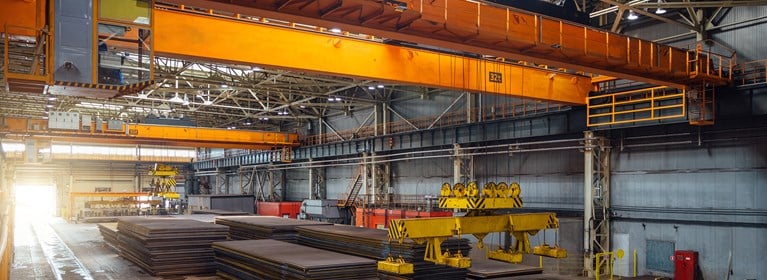
Understanding and Preventing Overhead Crane Hazards
Crane Systems | Safety and Training | By | Aug 08, 2022
Overhead cranes are widely used by companies in the manufacturing and construction industries to lift and transport materials. These systems make operations more straightforward and safer when installed and operated correctly. Overhead crane accidents, however, leave many people injured or killed yearly. Preventing these disasters requires workers to recognize specific hazards during operations and follow safety procedures to avoid them. The three most common overhead crane hazards are overloading, swinging loads and collisions, and dropped loads. This blog will discuss each hazard and technology solutions to reduce the risks.
Common Overhead Crane Hazards
Overloading a Crane
An overloaded crane is subject to structural stresses that can lead to irreversible damage. Overloading can result from a load that swings or drops suddenly, defective components, hoisting a load beyond its capabilities, dragging a load, or side-loading.
Swinging Loads and Collisions
Often referred to as "side-loading" or an “off-center pick,” side pulling occurs when a hoist is used in a manner other than for a vertical lift. When an operator does not center the hoist over the load before lifting, the load will swing towards the load’s center of gravity. Not only is a swinging load a significant safety hazard, but it also slows down productivity.
Dropped Loads
Materials falling from overhead cranes are a significant concern at any work site or construction site. Several factors can lead to severe injuries or deaths, including visual impairment, two-blocking, slipping, mechanical failure, or operator incompetence. For instance, a load that is not secured correctly could slip and cause significant damage to workers and property in the area.
To help prevent these potential disasters, all equipment should undergo routine maintenance checks, the operator should perform daily crane inspections, and all employees should wear proper PPE.
Overhead Crane Safety Preventative Systems
The address the many potential hazards, cranes can be retrofitted with preventive measures to maintain overhead crane safety. Below are a few examples.
Reducing the risk of collisions means increased operator safety, lower maintenance costs, and improved productivity and uptime. Collision avoidance technology can help you avoid crane-to-crane and crane-to-wall collisions in your facility. It takes the guesswork out of how long a crane can traverse toward another structure before needing to slow down or stop.
Drive Synchronization Technology
Drive synchronization makes it possible to sync multiple hoists on one or more bridges. This VFD-embedded firmware allows you to synchronize the VFDs on each hoist to precisely control their motion. It ensures the operator does not make an uneven lift, reducing the risk of a dropped load.
Drive synchronization firmware is ideal for operating multiple hoist applications independently or in tandem. It is also suitable for synchronizing multiple trolleys on a single bridge or multiple motions between two or more cranes.
Besides being dangerous for your employees, swinging loads can damage equipment, resulting in costly repairs and downtime. A hoist is nothing more than a pendulum, and acceleration and deceleration of a load naturally cause the pendulum to swing. A sway control system keeps the load steady by counteracting the pendulum swing while the operator traverses the crane. The crane operator can then concentrate on lifting and lowering the load without controlling the load's swing while it moves.
Columbus McKinnon offers pre-engineered and custom overhead lifting solutions that include all this technology and more. Contact us today for information on utilizing overhead crane safety systems in your facility to keep your workers safe and improve productivity and uptime.
Related Articles
As cranes and crane controls have become more sophisticated, so too has the information we can obtain from them. Not only do cranes lift and move materials that we as humans cannot, they also provide a wealth of information about the equipment and the load being moved. When equipped with crane monitoring technology, cranes can help us determine when maintenance or component replacement is needed or if the crane is at the end of its productive life.
When operating an overhead crane, safety is essential. Whether it's protecting operators from dangerous swinging loads or preventing cranes from colliding with one another, overhead crane safety systems allow you to build intelligence right into your overhead lifting system, helping keep your workers safe and your facility accident-free.
Let's take a closer look at five overhead crane safety systems that can have a significant impact on your operations.
Dangers Of Overhead Crane Side Pulling
Staying Safe in Overhead Lifting Applications
Learn how to prevent side pulling on cranes and hoists in your facility and available technologies designed to reduce crane side pulling.



 North America - EN
North America - EN





